When you’re looking to fine-tune your bike’s performance, you’ll often turn to products like the Power Commander, a line of fuel injection modules produced by Dynojet. These devices allow riders to adjust fuel maps and optimize performance, directly impacting horsepower, torque, and fuel efficiency. The Power Commander V (PCV) has been a staple in the market, allowing precise control over fuel delivery and timing. Meanwhile, the newly released Power Commander 6 (PC6) offers advancements on this established technology.
The transition from PCV to PC6 holds significance for riders aiming to maximize their motorcycle’s potential. Dynojet has designed the PC6 to keep pace with technological advancements and regulatory demands. One pivotal change noted by Dynojet is the PC6’s adjustment range for fueling, now limited to +/- 15%, adhering to tighter environmental regulations imposed by entities like the EPA. This modification affects how riders and tuners can manipulate the bike’s fueling in comparison to the broader range offered by the PCV.
Although the PCV is no longer in production, many riders still debate the merits of upgrading to the PC6. The decision often rests on individual needs, the specific motorcycle model, and the intended use of the bike—be it for casual rides or competitive racing. The comparison also extends to the installation process, cost-to-benefit ratio, and availability of maps and support for both devices. It’s essential for prospective users to weigh these factors carefully, considering the PC6’s new features against the PCV’s longstanding reputation and broader tuning range. But what else do you need to know? Keep reading and let’s get into it!
Related reads:
– The Best Harley Davidson Tuner Is Revealed (+5 Alternatives)
– The Best Tuner For Milwaukee 8 114 Engines (+Alternatives)
– Best Tuner for Harley 103 Gets Revealed (By An Expert)
– ThunderMax vs Power Commander: Who Packs The Punch +Value?
Overview of Power Commander Models
The Power Commander plays a crucial role in optimizing motorcycle engine performance. It is essential to understand the progression from the Power Commander V (PCV) to the newer Power Commander 6 (PC6), focusing on their specific features and the advancements introduced with the PC6.
Power Commander 5 vs 6 Changes and Updates
Dynojet has developed these modules over time, with the Power Commander 6 being the latest iteration. Launched after the well-established Power Commander V, the PC6 builds upon its predecessor’s successes and incorporates new adjustments to meet evolving regulatory standards.
Power Commander V (PCV) Features
The Power Commander V is renowned for allowing detailed tuning and adjustability for a motorcycle’s fuel injection system. It provides the ability to modify fuel maps, which can result in improved throttle response and power output. Released prior to the PC6, it allows users to influence fuel mixture settings across a wide range of engine speeds and loads, accommodating various exhaust and air intake configurations.
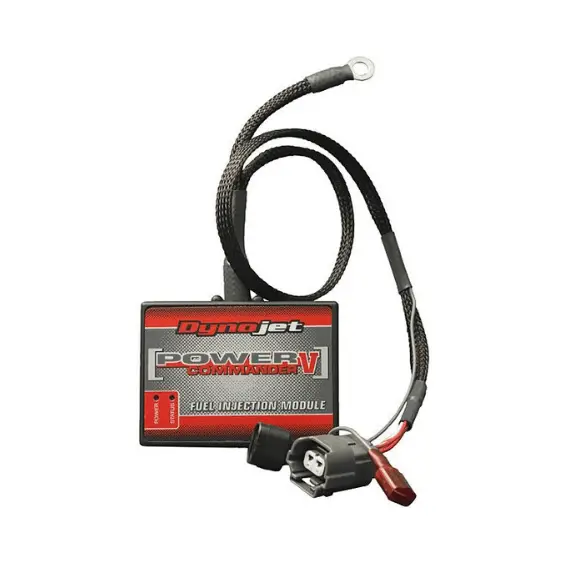
Power Commander 6 (PC6) Upgrades
The Power Commander 6 offers various upgrades over the PCV. While maintaining the core function of fuel tuning, the PC6 introduces limitations to the fueling adjustment range in response to EPA standards, with a capped range at +/- 15% from the base map provided by Dynojet. This model continues to advance the potential for motorcycle optimization while adhering to stricter environmental guidelines.

Software and Map Configuration
When configuring a Power Commander unit, software and map setup are fundamental for optimizing motorcycle performance. They allow for precise fuel mapping and granular control over how the motorcycle utilizes fuel data.
Available Maps and Base Map Installation
To begin, the Power Commander software, Power Core, provides access to a range of pre-configured maps. These maps serve as a base for fuel management. Users select and install a base map that closely matches their motorcycle’s configuration—taking into account factors like the exhaust system and air filter. The correct base map sets the foundation for further refinements.
Advanced Mapping Features
For enthusiasts seeking more tailored performance, both Power Commander V and VI offer advanced mapping features. It enables riders to customize fuel maps for each throttle position and RPM range, providing greater accuracy in fuel delivery. This granular level of control can result in smoother throttle response and optimized power output. Riders have the option to tweak these maps manually or through real-time adjustments while riding.
Firmware and Software Updates
Keeping the Power Commander’s firmware and software updated is crucial for maintaining compatibility with new features and improved functionality. Dynojet regularly releases firmware updates, which can be downloaded and installed using the Power Core software. These updates may include new maps, enhanced tuning capabilities, or fixes for any known issues, ensuring the Power Commander operates with the latest advancements in motorcycle tuning technology.
A read for later: ECU Flash vs Power Commander: Which is Best (and Why)
Hardware and Installation Components
When upgrading a motorcycle with a Power Commander unit, one should consider the differences in physical hardware, installation processes, and compatibility. These aspects are crucial for a proper fit and performance tuning.
Physical Hardware Differences
Power Commander V and Power Commander 6 house distinct hardware designs. The more recent Power Commander 6 tends to have a more compact layout and may include updated electronic components that reflect the latest in fuel management technology. Both models typically connect to a motorcycle through a wiring harness. However, the Power Commander 6 may include additional wiring or connectors not found in the Power Commander V, which could affect the installation process or compatibility with certain motorcycles.
Installation Process
Installation of a Power Commander device involves attaching the unit to the motorcycle’s ECU via a wiring harness specifically designed for the model. The user must ensure that each connection is secure for the unit to function correctly. After physically installing the Power Commander, it must be connected to a computer or laptop using a USB cable for map and firmware updates. Precise instructions vary between Power Commander V and Power Commander 6, but generally, the essential steps remain the same.
Compatibility with Motorcycles
Compatibility is a key consideration as not all Power Commander units fit every motorcycle model. The Power Commander V and 6 each support a variety of models and years, but a user should verify compatibility with their specific motorcycle before purchase. The unit’s wiring harness must match the motorcycle’s ECU connectors, and no two models are exactly alike. If necessary, a Power Commander may come with motorcycle-specific instructions and hardware to ease the installation process.
Tuning and Performance
In the realm of motorcycle enhancement, the tuning and performance features of the Power Commander V and Power Commander 6 stand out. They offer riders sophisticated control over fuel management and engine parameters, transforming the bike’s responsiveness and efficiency.
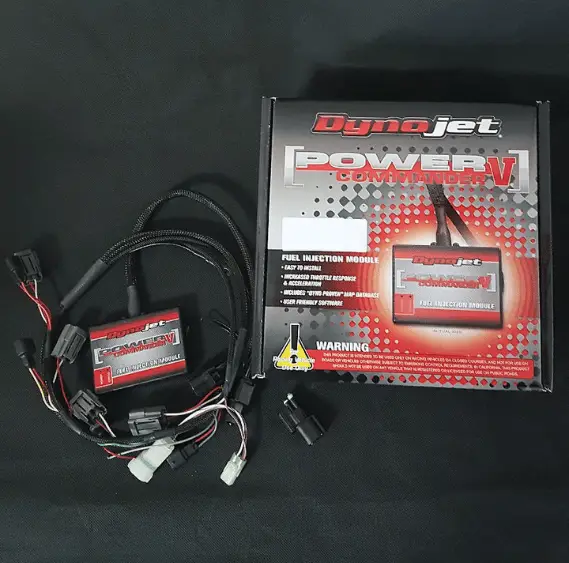
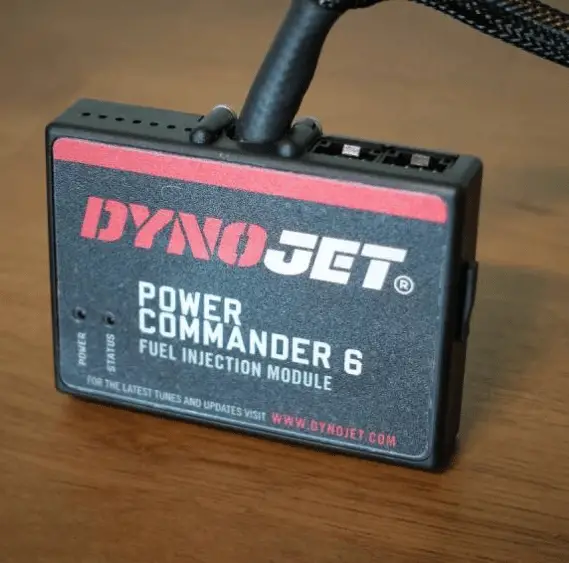
Fuel Adjustments and Injection Module
The Power Commander V and Power Commander 6 are fuel controllers that interface with the motorcycle’s fuel injection module, allowing for precise adjustments to the air/fuel ratio. The Power Commander 6 limits riders to a +/- 15% fueling adjustment from the base map supplied by the manufacturer. In contrast, the Power Commander V offers a broader range of fuel adjustments, providing the rider with more flexibility in tuning.
Autotune Functionality
Autotune capability is a distinct feature for riders who seek performance optimization. It works by automatically adjusting the air/fuel ratio in real-time. The Power Commander V can be paired with an Autotune kit, which uses wideband O2 sensors and a control module to make on-the-fly adjustments for optimum air/fuel ratio across all rpm and throttle positions. The Power Commander 6 inherits this feature, though details on its autotune functionality specifics are less available.
Ignition Timing and Throttle Response
Adjusting ignition timing is critical for achieving maximum performance. Both models permit changes to the ignition curve, which affects how the motorcycle handles and accelerates. Throttle response, a rider’s tactile feedback from twisting the throttle, is improved by refining the ignition timing and fuel injection mapping. The capability to tweak these settings allows the motorcycle to respond more quickly to rider inputs, enhancing the overall riding experience.
Additional Features and Expansion
Both the Power Commander V (PCV) and Power Commander 6 (PC6) offer advanced features for precise motorcycle tuning. The expansion capabilities and additional features enable riders to further customize their riding experience.
Map Switching and Inputs
Power Commander V and Power Commander 6 both support map switching, which allows riders to switch between different preset tuning maps. This functionality is very useful to adapt the motorcycle’s performance to varying conditions or preferences. They typically use a gear input feature that can modify the fueling and ignition parameters for optimal performance with each gear change.
- Map Switch: Activated via a physical switch; allows the user to toggle between different maps.
- Gear Input: Allows for gear position-based map adjustments.
Integration with Quickshifters
The integration with quickshifters is seamless on both devices. A quickshifter allows for clutchless upshifting, and the Power Commander units can manage the cut-off time to ensure smooth gear changes.
- Quickshifter: Both models can be paired with a quickshifter, managing ignition interruption for flawless gear shifts.
Secondary Modules and Analog Inputs
Users can connect additional modules to both the PCV and PC6 for enhanced tuning.
- Ignition Module: Used for more detailed ignition adjustments, can be added to fine-tune the ignition timing for each gear or RPM range.
- Secondary Fuel Module: Connects to secondary fuel injectors for precise control over the entire RPM range.
- Analog Inputs: Support for external devices, like temperature sensors, to input data for corresponding tuning adjustments.
Each of these features contributes to a highly customizable and adaptive tuning system, crafted for those who want meticulous control over their motorcycle’s performance.
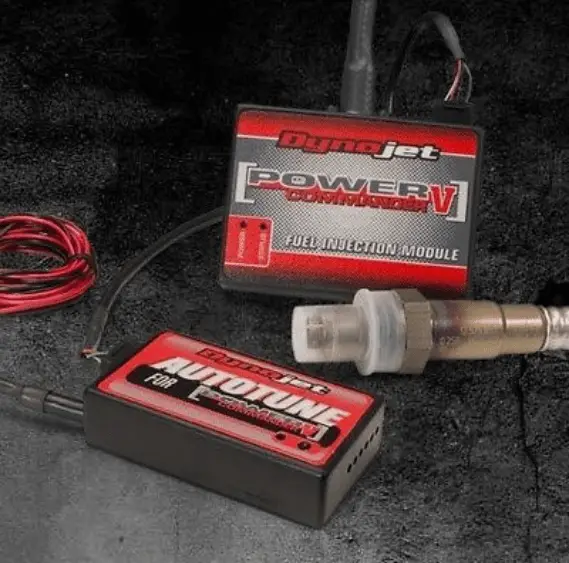
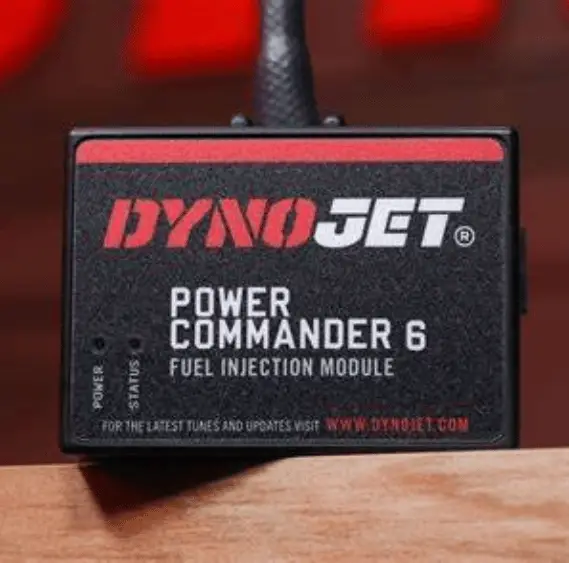
Compatibility and Support
The Power Commander V and Power Commander 6 units offer distinct levels of compatibility and support. Choosing the right version will depend on the specific make and model of the motorcycle as well as the desire for ongoing support and user experience enhancements.
Motorcycle Make and Model Compatibility
Both Power Commander V (PCV) and Power Commander 6 (PC6) support a range of motorcycles from manufacturers like Honda, Kawasaki, Suzuki, Yamaha, and Harley-Davidson. The PC5 tends to have wider compatibility with earlier models, while the PC6 is designed with newer models in mind. For instance, a Honda CBR 1000RR owner would need to confirm which Power Commander unit is compatible with the specific year of their motorcycle. The PCV has historically been a go-to choice for a broad spectrum of bikes, including classic models like the Suzuki Hayabusa, where riders may not require the most recent technological updates.
User Experience and PC Support
The user interface of the Power Commander series allows riders to adjust and fine-tune their motorcycle’s fuel mapping. The PC6 offers a modern interface with a more limited range for fuel adjustment as a result of tighter EPA regulations. This newer model is built with a focus on user experience, flaunting a more streamlined design for easier handling.
Support for the devices comes in various forms, but it is important to note that Dynojet provides updated manuals, installation guides, and software for both PCV and PC6. Users may find that support for the Power Commander 5 is more established due to its longer presence in the market, while the Power Commander 6 benefits from the latest technological advancements and may see ongoing updates enhancing its feature set and user experience.
Both models are well-regarded for their contributions to motorcycle performance, and the choice between them often hinges on the specific needs of the rider and the compatibility with their motorcycle model.
Warranty and Manufacturing Insights
When considering the Power Commander V and Power Commander 6, buyers should closely evaluate warranty coverage and manufacturing quality. These factors significantly influence long-term satisfaction and reliability.
Warranty Coverage
The Power Commander V and Power Commander 6 typically come with a one-year warranty from the date of purchase. This warranty often covers defects in materials and workmanship under normal use. Buyers should note that warranty terms may vary depending on the seller, and they should verify the specifics at the time of purchase.
Quality of Manufacture
Dynojet, the manufacturer of Power Commander units, is known for producing their equipment in the USA, which often translates to strict quality control standards. Both models are regarded for their robustness. It is imperative for purchasers to confirm the authenticity of the units to ensure they receive the high-quality product manufactured by Dynojet.
Additional Considerations
When evaluating the Power Commander V and Power Commander 6, riders must weigh environmental regulations against the enhancements in performance these devices promise.
Environmental Compliance
The Power Commander 6 aligns more closely with environmental regulations, particularly California’s stringent emission standards. This is evidenced by its limitation to a +/- 15% fueling adjustment, a compliance measure likely in response to EPA pressure. On the other hand, the Power Commander V does not have this limitation, which may affect its usability in regions with strict environmental controls, like California, where Compliance, Emission, and Labelling (CEL) requirements are more rigorous.
Fuel Efficiency and Power Gains
Both Power Commander models aim to improve fuel efficiency and provide power gains. However, the Power Commander 6’s restricted adjustability can impact tuners’ ability to extensively customize fuel maps. Riders must consider whether the broader adjustability range of the Power Commander V offers significant advantages for achieving the desired balance between fuel efficiency and power output. Despite this, some riders may find the adjustments provided by the Power Commander 6 to be adequate for their needs.
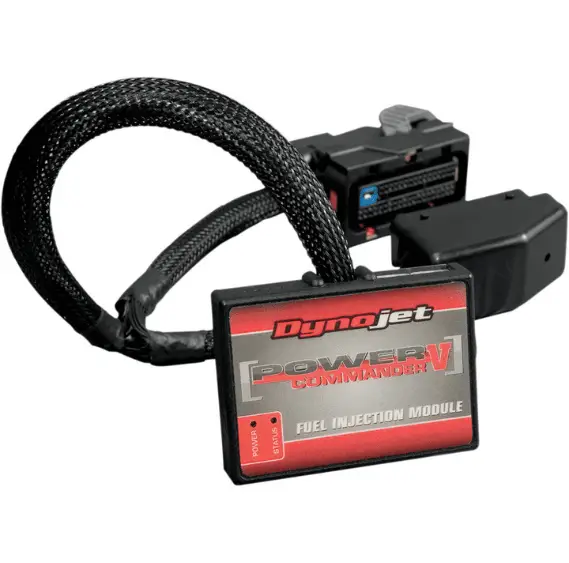
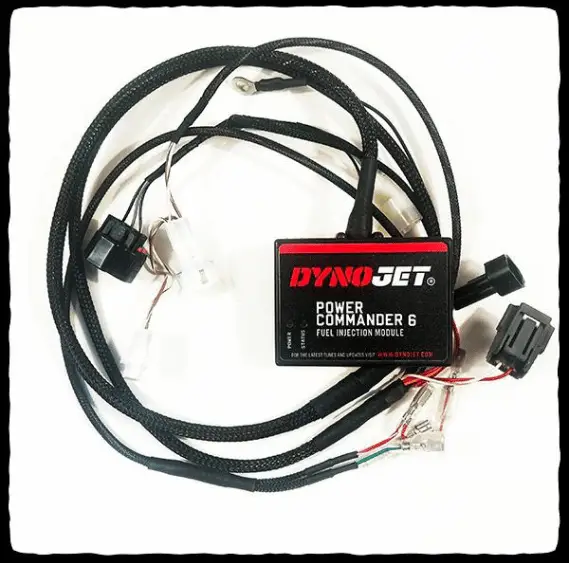
Product Resources
When purchasing the Power Commander V or Power Commander 6, riders have access to a variety of support materials to ensure they can utilize their fuel management systems effectively.
Manuals and Installation Guides
Each Power Commander unit comes with a comprehensive manual that outlines everything from setup to troubleshooting. Riders can find detailed installation guides that walk through step-by-step processes tailored to their specific motorcycle model.
- Power Commander V: Manuals that include instructions for mapping and software installation.
- Power Commander 6: Updated installation guides reflecting the changes in hardware and software capabilities.
Access to Online Resources
The manufacturer’s website provides a central hub of online resources for both the Power Commander V and Power Commander 6. Customers can download the latest firmware updates, access various tuning maps, and subscribe to a newsletter for the latest updates on software and features.
- Firmware and Software: Direct links to download the latest updates.
- Tuning Maps: A collection of pre-configured maps for different models and modifications.
- Newsletter Subscription: An option for customers to stay informed on the latest news and product enhancements.
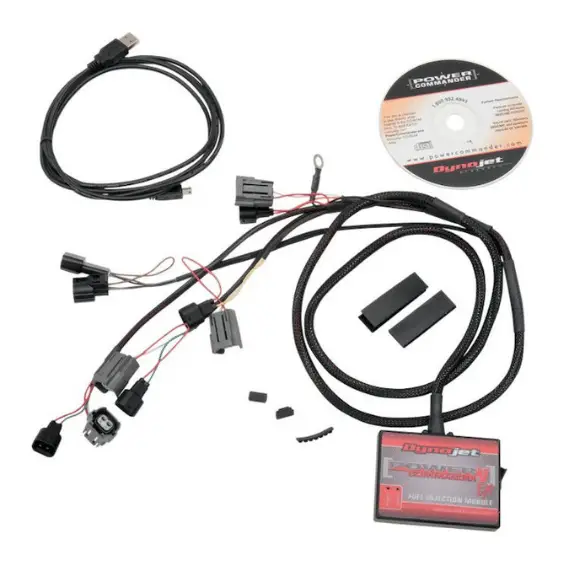
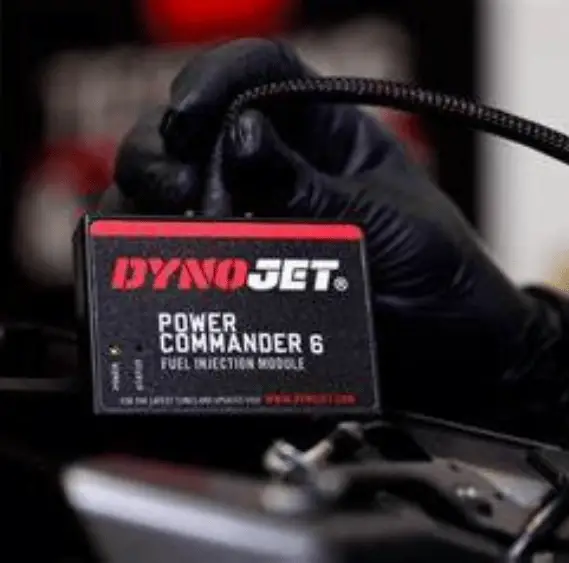
Wrapping Up
In the pursuit of unleashing a sportbike’s full potential, the choice between the Dynojet Power Commander 5 (PCV) and Power Commander 6 is nuanced. The Power Commander 5 has established itself as a reliable tool for enhancing performance with a legacy of support, a breadth of availability, and the option for detailed custom map creation. It allows for adjustments beyond the ±15% fueling parameter set by the newer Power Commander 6, which can be an important factor for riders seeking extensive modifications.
The introduction of the Power Commander 6 does present advancements, particularly in its design tailored to meet more stringent regulatory constraints. Notably, this model operates with a fueling adjustment limitation in response to EPA regulations. Yet, this constraint may affect riders looking for significant tuning capabilities, as it limits the extent of customization compared to the PCV.
For motorcyclists aiming at optimal performance within regulated parameters, Power Commander 6 emerges as a compliant and contemporary solution. However, if the intention extends towards comprehensive tuning without the confines of a preset fuel adjustment range, the Power Commander 5 stands as a preferred choice. Riders should weigh the benefits of the Power Commander 6’s compliance against the Power Commander 5’s flexibility.
The decision, therefore, pivots on the specific needs and intentions of the rider. Factors such as desired extent of customization, compliance with emissions regulations, and compatibility with existing modifications should guide the selection process. Ensure that whichever version is chosen aligns with the sportbike’s requirements and the rider’s expectations to achieve the desired performance outcome.